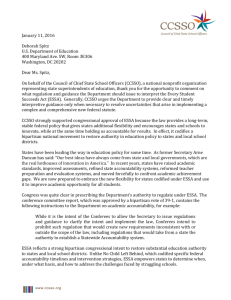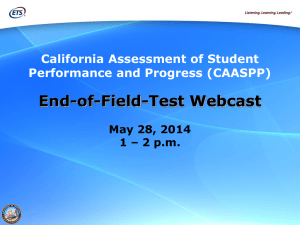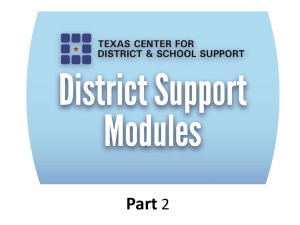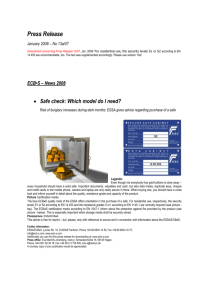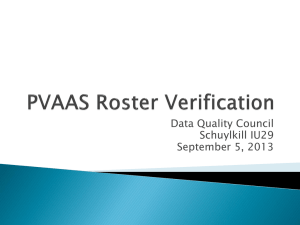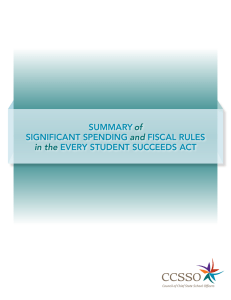Measurements
advertisement
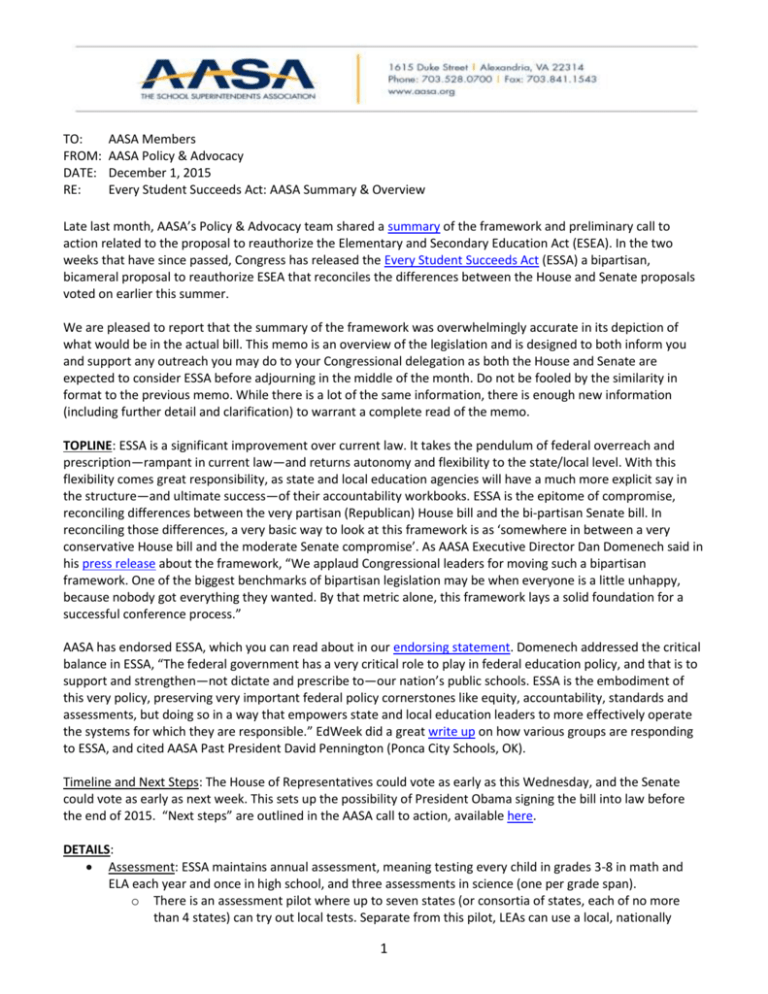
TO: FROM: DATE: RE: AASA Members AASA Policy & Advocacy December 1, 2015 Every Student Succeeds Act: AASA Summary & Overview Late last month, AASA’s Policy & Advocacy team shared a summary of the framework and preliminary call to action related to the proposal to reauthorize the Elementary and Secondary Education Act (ESEA). In the two weeks that have since passed, Congress has released the Every Student Succeeds Act (ESSA) a bipartisan, bicameral proposal to reauthorize ESEA that reconciles the differences between the House and Senate proposals voted on earlier this summer. We are pleased to report that the summary of the framework was overwhelmingly accurate in its depiction of what would be in the actual bill. This memo is an overview of the legislation and is designed to both inform you and support any outreach you may do to your Congressional delegation as both the House and Senate are expected to consider ESSA before adjourning in the middle of the month. Do not be fooled by the similarity in format to the previous memo. While there is a lot of the same information, there is enough new information (including further detail and clarification) to warrant a complete read of the memo. TOPLINE: ESSA is a significant improvement over current law. It takes the pendulum of federal overreach and prescription—rampant in current law—and returns autonomy and flexibility to the state/local level. With this flexibility comes great responsibility, as state and local education agencies will have a much more explicit say in the structure—and ultimate success—of their accountability workbooks. ESSA is the epitome of compromise, reconciling differences between the very partisan (Republican) House bill and the bi-partisan Senate bill. In reconciling those differences, a very basic way to look at this framework is as ‘somewhere in between a very conservative House bill and the moderate Senate compromise’. As AASA Executive Director Dan Domenech said in his press release about the framework, “We applaud Congressional leaders for moving such a bipartisan framework. One of the biggest benchmarks of bipartisan legislation may be when everyone is a little unhappy, because nobody got everything they wanted. By that metric alone, this framework lays a solid foundation for a successful conference process.” AASA has endorsed ESSA, which you can read about in our endorsing statement. Domenech addressed the critical balance in ESSA, “The federal government has a very critical role to play in federal education policy, and that is to support and strengthen—not dictate and prescribe to—our nation’s public schools. ESSA is the embodiment of this very policy, preserving very important federal policy cornerstones like equity, accountability, standards and assessments, but doing so in a way that empowers state and local education leaders to more effectively operate the systems for which they are responsible.” EdWeek did a great write up on how various groups are responding to ESSA, and cited AASA Past President David Pennington (Ponca City Schools, OK). Timeline and Next Steps: The House of Representatives could vote as early as this Wednesday, and the Senate could vote as early as next week. This sets up the possibility of President Obama signing the bill into law before the end of 2015. “Next steps” are outlined in the AASA call to action, available here. DETAILS: Assessment: ESSA maintains annual assessment, meaning testing every child in grades 3-8 in math and ELA each year and once in high school, and three assessments in science (one per grade span). o There is an assessment pilot where up to seven states (or consortia of states, each of no more than 4 states) can try out local tests. Separate from this pilot, LEAs can use a local, nationally 1 recognized test (think: SAT or ACT) at the high school level instead of the state test. The bill also allows for computer adaptive assessment. Standards: You have to have high standards. The state and local education agencies make that decision. There is no federal role or incentivization for a specific set of standards. The state can choose Common Core, can use Common Core but call it ‘UnCommon Core’, can acquire another set of generated standards or can work to make their own standards. See this clarification on how ESSA prohibits federal involvement in the Common Core. Accountability: This is where a lot of the ‘whittling back’ of federal overreach can be found: o These plans would go into effect for the 17-18 school year. The 15-16 school year would be the last year states and LEAs would have to submit data as currently required. Waivers, in their current structure, would expire on July 31, 2016. This means that the 16-17 year could serve as a soft/trial run for all (or pieces) of the new/proposed state accountability workbook. o States must continue to disaggregate data by student sub group and must continue to calculate graduation rates using the adjusted cohort graduate rate as established in the 2008 regulations. o There are two additional buckets in accountability that will trigger action: States must identify and intervene in schools in the bottom 5% and in high schools that graduate less than 67% of their students. States will generate this list every three years, and states will establish the exit criteria (meaning if you can improve student learning/achievement in one year, you could—if the state structures it this way—be off the list in one year, rather than being stuck there for three). States must include provisions related to intervention in consistently underperforming schools. For LEAs in this bucket, as determined by the state, the LEA will come up with a plan for improvement. The state will determine the number of years an LEA with this designation can go without showing improvement, and then the state will require additional supports/intervention. There are NO prescribed turn around models; states and LEAs determine those options/combinations. o Interventions: For the bottom 5%: LEAs design an evidence-based plan and the effort is monitored by the state. The state can step in with its own plan if the LEA continues to struggle (the state must make this determination is less than four years). The state could take over, fire the principal, convert to a charter, etc… As for choice, an LEA can allow for choice out of the lowest-performing schools, with a priority for the neediest students. For struggling subgroups: Schools design an evidence-based plan to support the group of students that are struggling. This could include a new curriculum and/or staffing up with an experienced coach/trainer to support teachers. School effort is monitored by the LEA, who will step in if the school effort falls short. States and LEAs are obligated to be more involved in schools with subgroups that are chronically underperforming and not responding to local interventions. The performance of these subgroups, to trigger state/district action, will mirror that of the bottom 5 percent of schools. o The state accountability plan must include sub-group performance targets. This is NOT annual measurable objectives in that the data on these targets is merely reported; it triggers no action. That is, a school that struggles to meet these targets will NOT trigger intervention. These targets will be long-term and interim, and must include targets for graduation rates, reading and math scores and English Language proficiency for English Language Learners. o The accountability construct empowers state and local education agencies to shape their accountability workbooks in a way that diminishes continued overreliance on high-stakes, onetime standardized testing. In designing an accountability workbook, academic factors must represent more than half (at least 51%) of all indicators, meaning that up to 49% of the accountability construct can be focused on whole-child and other critical, non-academic, indicators. 2 o In designing accountability workbooks, there is a list of indicators that can be considered, which varies between elementary, middle and high schools. Elementary/Middle Schools: Plans have to include at least four indicators in their system. Three are academic (proficiency on state tests, ELL proficiency and one other academic factor that can be broken out by subgroup). The fourth indicator is non-academic and could include student engagement, educator engagement, access to and completion of advanced coursework, post-secondary readiness, school climate/safety, or anything else the state deems relevant. High Schools: Will look much like elementary/middle schools, but they also have to include graduation rates. That is, proficiency on tests, ELL proficiency and grad rates plus a fourth, non-academic indicator, and test participation (as a standalone factor, not an indicator). Testing Participation: States still have to test 95% of their students. This element (participation) must be included in the accountability workbook as standalone factor; it is no longer an indicator. States have to figure out how they will include participation in their workbook, and that will include how to respond to LEAs that do not reach the threshold. Opt-Out: As mentioned above, ESSA maintains the 95% threshold for participation. States are free to craft their own opt-out law. Under current law, failure to reach the 95% threshold triggers the label of ‘failure’. Under ESSA, states and LEAs determine what happens to schools that miss the target. States have to anticipate low testing participation into their accountability systems, but have wide latitude in how to do so. Title I: o School Improvement Grants are consolidated into Title I. The funds previously available under SIG will flow through the regular Title I formula. There will be a set-aside of approx. 7%, representing the current 4% set aside for school improvement under Title I PLUS the state's SIG amount. States must move at least 95% of that 7% to schools for innovation. States can choose whether to allocate these innovation dollars through competition or formula. o Portability IS OUT. ESSA includes a weighted student formula for Title I. This proposal will allow an LEA to aggregate its state and local dollars with its federal dollars (from Titles I-IV). This pilot program will apply to 50 LEAs, who can use these pooled dollars and design their own allocation formula in a manner that allows them to better target dollars to the neediest schools. This is NOT portability. This pilot will NOT change allocations at the state or district level. Rather, it allows districts greater authority over where the dollars flow in their schools. There is a requirement LEAs participating in this pilot demonstrate that needy schools receive at least as much under the weighted formula as they did before the pilot. We anticipate Republicans will tout this as ‘backpack funding’ or portability. While this is an increase in local control of spending, it is at the district level. True portability would have the money follow the child to the school of their choice regardless of actual need or levels of concentration, and the placement of that child would be determined by the family. In this pilot, the LEA is the entity allocating the dollars and will factor in concentrations of poverty with the added caveat of ensuring that the neediest schools don’t see an exodus of funding. This is in stark contrast to actual portability, where dollars would be diluted to a perpupil level and allocated blindly to the schools based on enrollment, not concentration of poverty. o Maintenance of Effort is IN. The House bill had eliminated this critical element and we are pleased to see that state and local education agencies will continue to have to invest at least 90% of what they did the year before in order to receive federal dollars. 3 o The Title I formula will be unchanged. Both the House and Senate proposals included formula rewrites, neither of which made it through. This means that Title I dollars will continue to be allocated in a manner that allows larger, but less poor, districts to receive a higher allocation of Title I dollars per child than their actual concentration of poverty would indicate. That said, we are OK with the status quo because we had reservations about what a compromised formula rewrite would look like. ESSA includes a requirement for Congress to do a study of the Title I formula, taking a very critical look at the issue of number and percentage weighting, and its impact on small, large, urban and rural schools. This is the exact research we have been advocating with in our efforts on the Title I formula and we are pleased to see formal movement by Congress. Precedent in ESEA reauthorization would include an update of the quintiles in the Title I formula. The quintiles are the enrollment ‘buckets’, where each threshold represents approximately 20% of the nation’s students. We had deep reservations about updating the quintiles without reworking the formula, because the threshold for the upper bound would have fallen by 10,000, meaning that more larger (but not necessarily poorer!) districts could max out under number weighting, further exacerbating the impact of inequitably allocating dollars away from smaller, poorer schools. No update of the quintiles reinforces the pressure to accurately address the very real, but unintended, consequences of the current formula. Rural Education: o AASA helped pen the original Rural Education Achievement Program (REAP) in 2001, and we are pleased to see that the changes we have long advocated are reflected in this bill. In a reauthorization that consolidated and eliminated many programs, it is wonderful to see REAP remain as a stand-alone program. o The US Education Department will have to do a study to evaluate how they are <not> serving rural schools. o Also, Rural School Consolidated Grant Applications are in, meaning that small, rural schools can coordinate to submit consolidated applications. This may be through their local education service agency. Funding Caps: The bill includes funding caps, though those numbers are written to the Bipartisan Budget Act of 2015, under which would be there is room for small increases in the years of this authorization. This authorization is for four years. Early Education: ESSA includes an early education component. This will be administered jointly through the Health/Human Services Department and US Education Department, with HHS acting as the fiscal agent. This program is in addition to Head Start and Child Care Development Bloc Grants. Alternate Assessment: AASA’s preferred position was no cap on alternate assessments. That is, we think that the local IEP team is best positioned to determine which students qualify for/need an alternate assessment. We are pleased with the compromise in ESSA. Alternate assessments will be capped at 1% at the STATE level. Local IEP teams will work to make their determinations as driven by IDEA. There are explicit prohibitions on both the Secretary and the state from forcing a local cap (as in current practice). LEAs will have an alternate assessment rate determined by need and the state is responsible for monitoring LEAs individually to determine the overall state level. Should a state find it has an alternate assessment rate above 1%, the state can pursue a waiver. Student Privacy: FERPA is out. The proposed commission to analyze/study student data and privacy is also out. That is, no student data/privacy reauthorization reference in this bill. School Climate: Programs in Title IV are consolidated into a bloc grant. This bloc grant will be formula to state and formula to local. When allocations are above $30,000 to the LEA, LEAs must use at least 20% of this allocation for well-rounded education and at least 20% for safe/healthy programming. Technology is an allowable use in this title. Spending on technology devises/equipment/software would be capped at 15%, but LEAs could use up to 60% of their grant under this program for technology-related activities, 4 including training teachers to use technology, blended learning, personalized learning, buying content, etc. Foster Care: Students in foster care have a right to remain in their school of origin, like homeless children though the transportation costs are allocated in a different manner. ESSA’s foster care provisions are that any additional transportation costs to be incurred would be assumed by the LEA only if the LEA was being reimbursed by the child welfare agency, agreed to share the costs with child welfare or if the district decided to cover those costs. If a school transfer occurs, records must be sent immediately. If child welfare has indicated in writing that it has a point of contact to work with schools, the LEA must designate a point of contact to work with child welfare. By 2017, the LEA must develop (with the local child welfare agency) written procedures for how to maintain children in foster care in school of origin and provide, arrange, and fund transportation (as appropriate). Expanded Data Collection Under Title IX (Gender Equity): Eliminated. Outside of this, there is a new potential data collection item (not in the CRDC) related to collecting information on post-secondary access by subgroup to public (and where appropriate, private) colleges and universities. Title II Formula: The Title II formula is revised in ESSA. It uses the Senate-adopted version, with tweaks to change the poverty population to a sliding scale, and to include the ramp down/hold harmless. Background Checks: The framework includes language related to the unfavorable practice of ‘pass the trash’ but stops short of the high level of prescription and redundancy with current state/local practice that had been considered. This is language we are ok with. Comparability: Maintained current law; we were opposed to a proposal to include teacher salary in the calculation. English Language Learners: Accountability for ELLs is shifted from Title III to Title I, a nod to making accountability for this group of students a bigger priority. In addressing accountability for ELLs, states have two options. They can continue with current law (including ELL test scores after they have been in the country for one year). Or, under the new option, there is a three-year ramp up: In the first year, the state can have ELLs take the assessments and publicly report the results but not have it count toward/against a school’s rating; in the second year, the state would incorporate ELL results in both math and reading. In the third year, ELL proficiency scores would be treated like that of any other student. Also, whereas current law only allows ELLs to be included/reported as ELLs for two years, ESSA allows former ELL students to be counted for up to four years. This addresses the ‘revolving door’ effect for ELLs for accountability purposes. Questions? Contact Noelle Ellerson, Associate Executive Director, Policy & Advocacy (nellerson@aasa.org) 5
